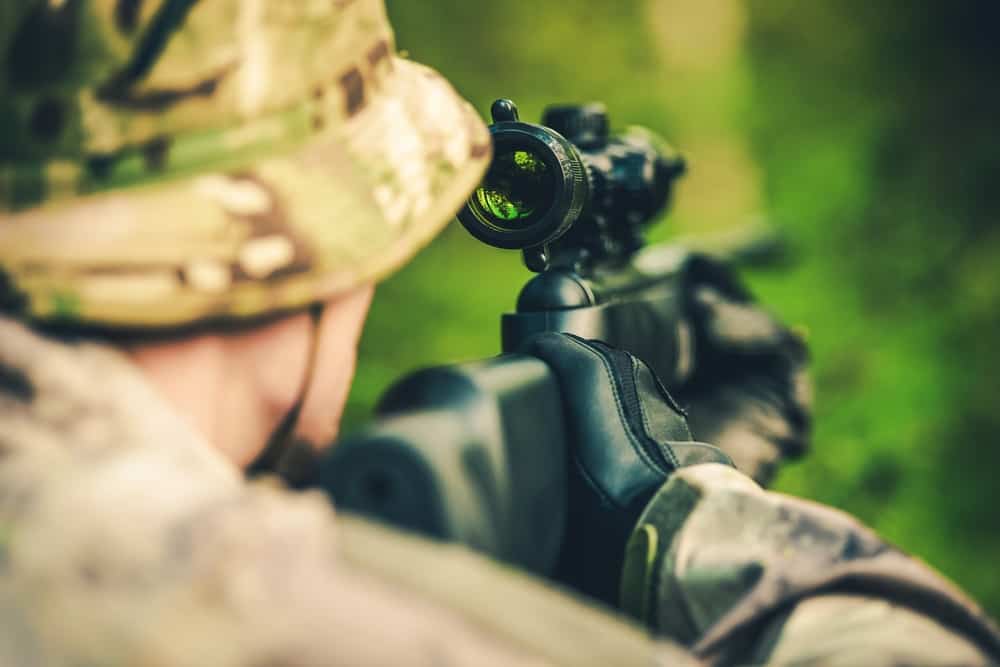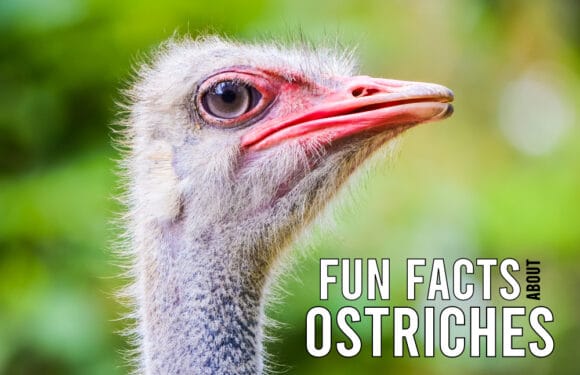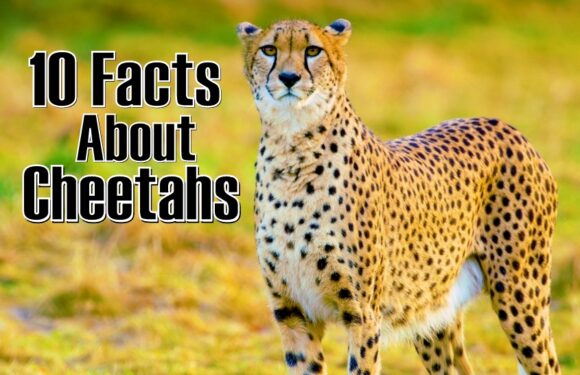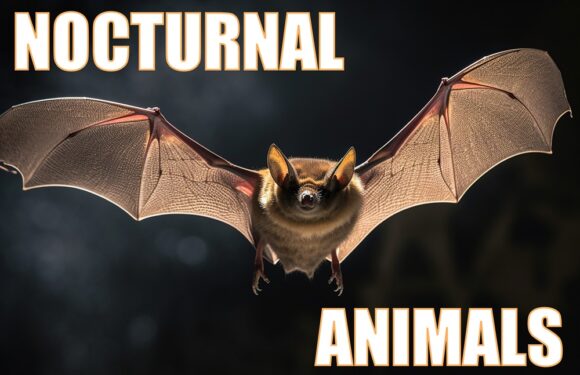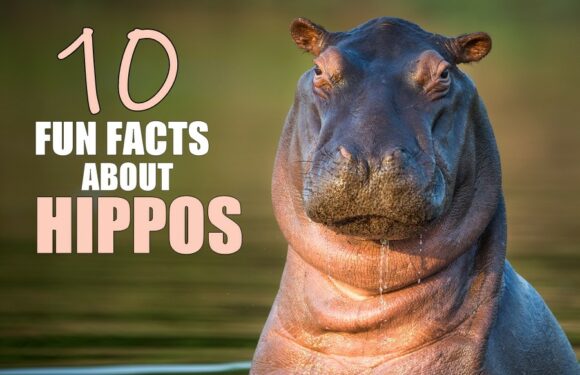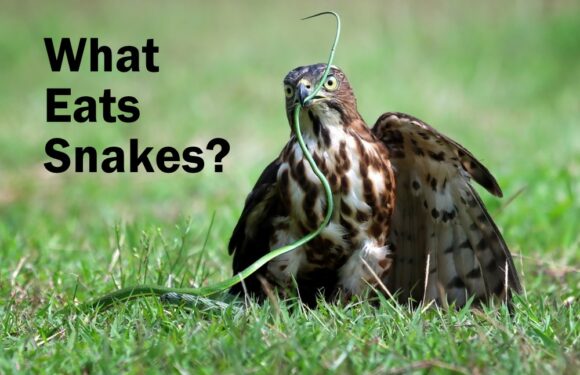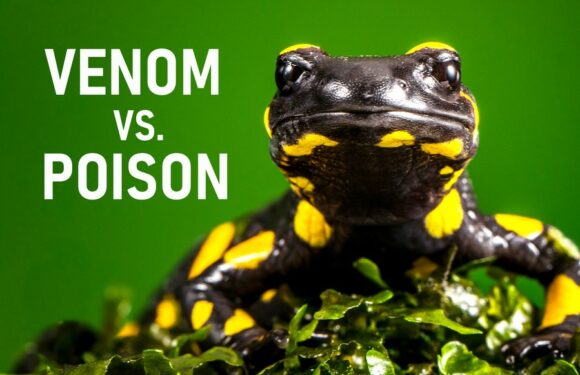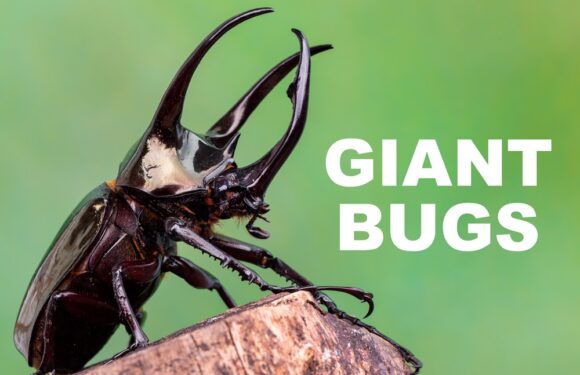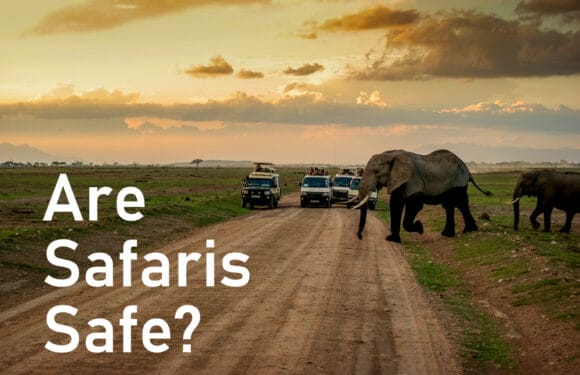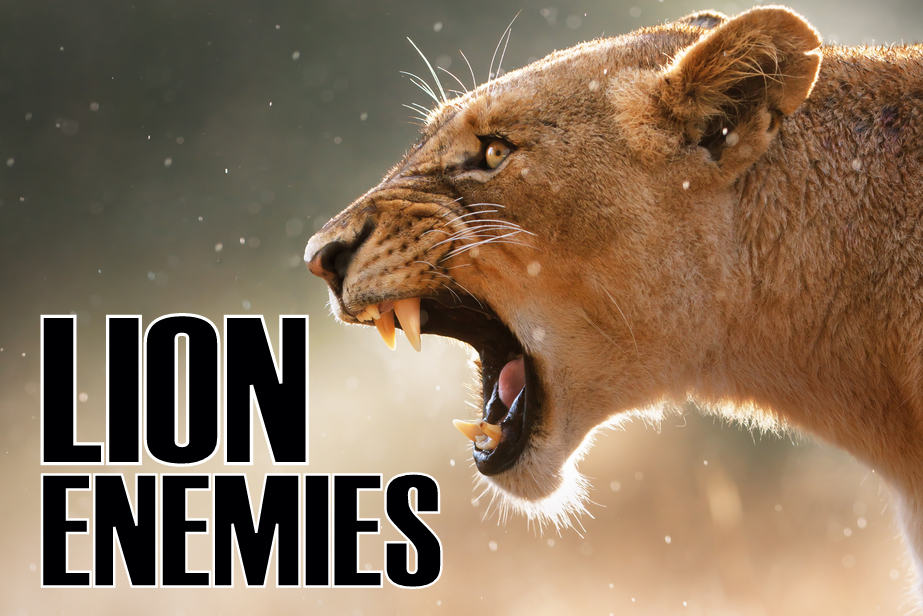
In the African savannah, the “King of the Jungle” reigns supreme. The lion is one of the most dangerous animals in the world. But, even kings have their adversaries. This article discusses the dynamics between lions and their natural enemies. While some, such as hyenas, are quite well known, others may surprise you.
Animals That Kill and Eat Lions
1. Hyenas
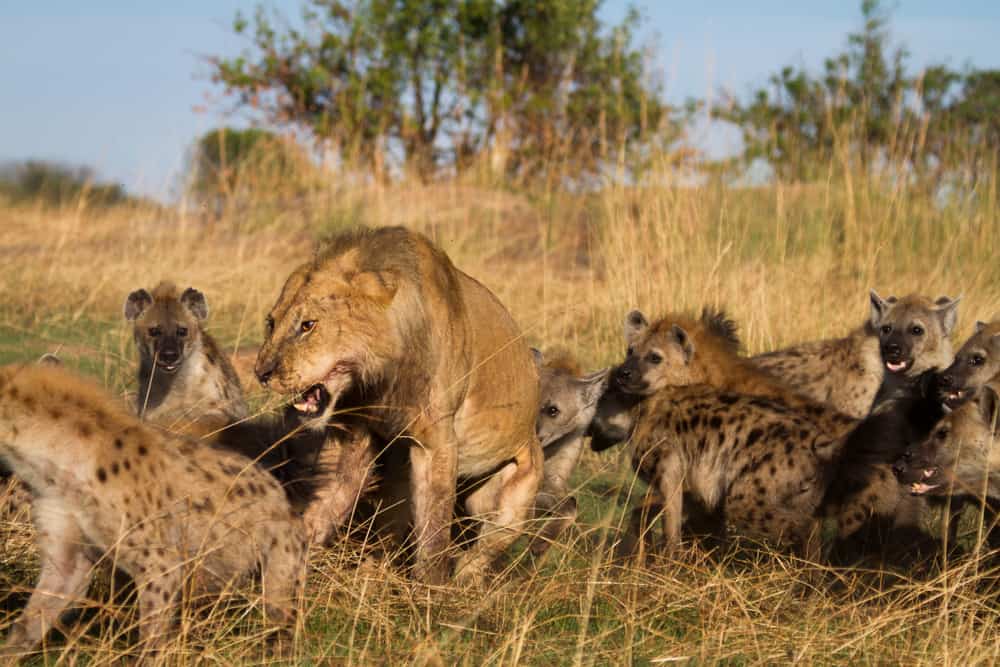
Hyenas are often depicted as dirty, ugly scavengers, yet in the wild, they are the biggest threat to lions. These two species engage in fierce competition over food sources, leading to epic confrontations. Hyenas, with their powerful jaws and strategic group hunting tactics, often challenge lions, especially when they outnumber them.
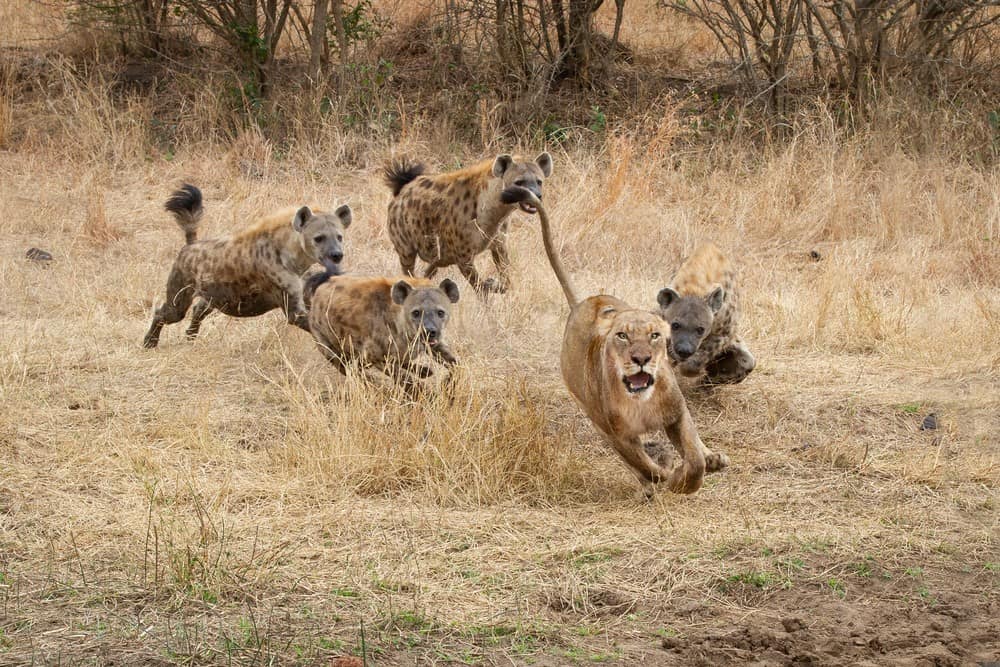
While a lone lion can dominate a few hyenas, the tables turn when more hyenas band together. In these group confrontations, hyenas can overwhelm a lion, potentially injuring or even killing it through sheer force and teamwork.
Hyenas can and will eat lions if the opportunity arises. They rarely, if ever, actively hunt lions for food, but can prey on lion cubs or sick, injured or weak adults. Hyenas have powerful jaws capable of breaking through bone, which allows them to consume almost every part of a lion carcass.
2. Crocodiles
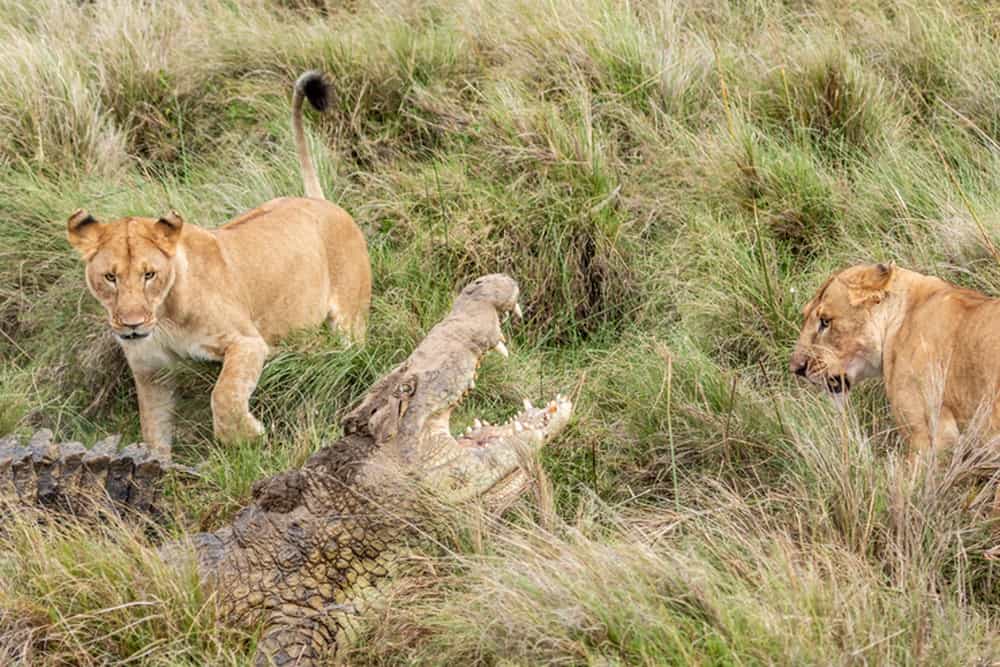
At the water’s edge, the crocodile is a dangerous enemy of the lion. These ancient reptiles pose a significant risk to lions coming to drink or cross water bodies. These ambush predators can drag a lion underwater, utilizing their powerful jaws to drown it, tear it up, or break its bones.
Although lions can swim, they are inferior compared to crocodiles when in the water. Therefore, lions are cautious around water bodies known to harbor crocodiles. However, lapses in vigilance can lead to deadly outcomes.
Crocodiles will consume a lion that has been caught in the water and they might also scavenge on a lion’s carcass, but they do not specifically hunt lions for food. Their attacks on lions are primarily defensive or territorial rather than for the purpose of predation.
3. Leopards
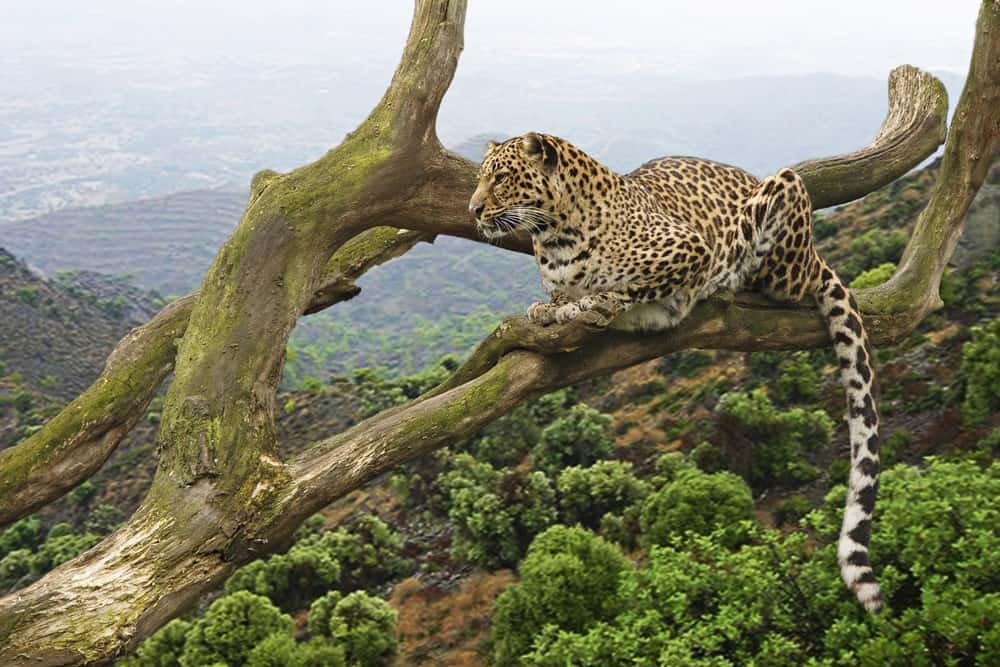
Leopards are solitary stealth masters of the African bush. But they occasionally find themselves in direct conflict with lions. Due to their overlapping territories, skirmishes over prey can occur. Leopards go to great lengths to avoid these confrontations. However, when clashes occur, the outcome heavily favors the lion due to its size and strength advantage. Leopards may be forced to abandon their hard-earned meals or stand up to the lion and risk fatal injuries. The leopard’s main defensive tactic is to keep away from lions by retreating to trees where lions cannot follow.
However, if given the opportunity, leopards will prey on lion cubs. They use their stealth to follow and observe lion prides, then pick off a cub when it is most vulnerable.
4. Baboons
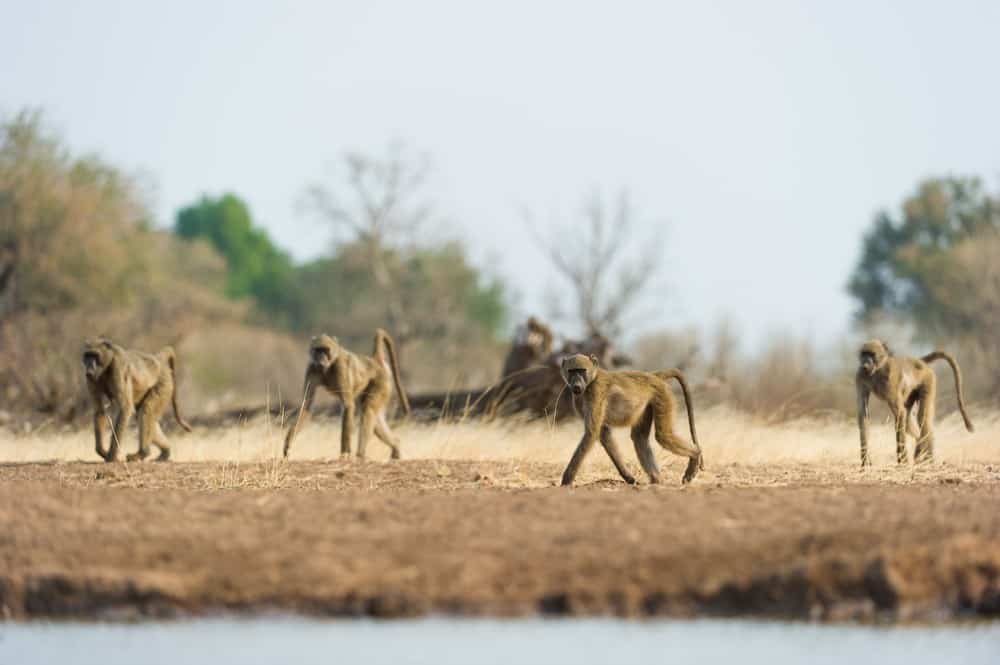
Baboons might seem an unlikely threat to the mighty lion, but these primates are fiercely protective of their troops. Armed with sharp teeth and a surprising level of hostility, baboons can become worthy adversaries when lions venture too close. Baboon troops band together to confront a lion that poses a threat. The collective show of aggression from a troop can be enough to deter a lion, especially if the lion is alone.
Typically, baboons try to avoid conflict with lions by retreating to the safety of trees where lions cannot easily follow. Lions can and do prey on baboons, particularly the young, old, or sick individuals who cannot escape as quickly. Predation usually occurs at night when lions are most active and baboons are at their most vulnerable.
On the other hand, there have been instances where baboons have mobbed, injured and killed young or isolated lions. They are known to steal lion cubs while the females are away from the den to go hunting. These cubs often end up as protein rich meals for the troop.
Animals That Can Kill Lions
5. Buffalo
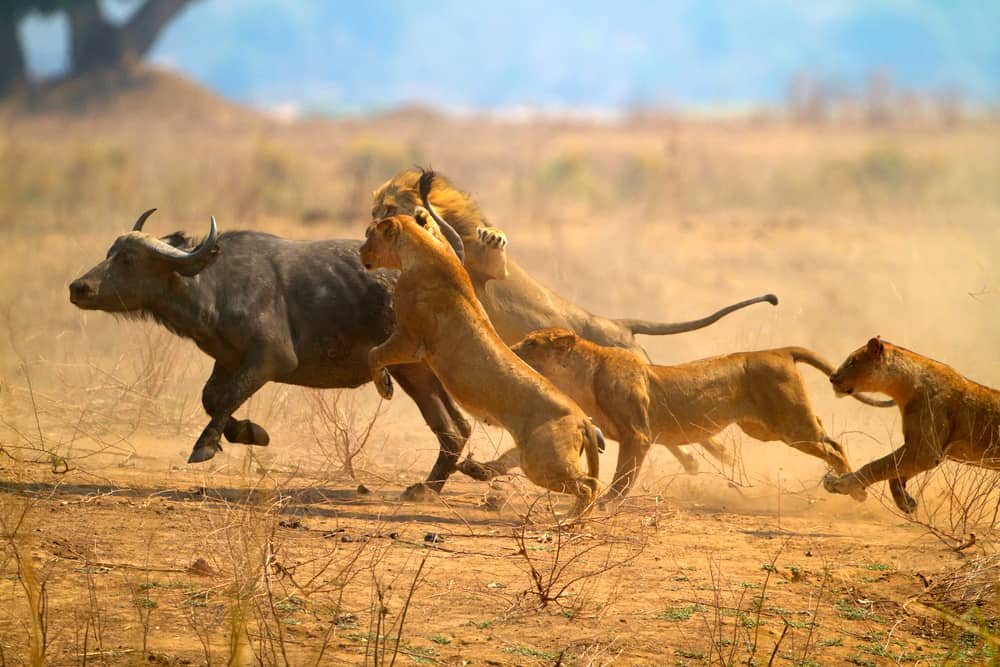
Among the lion’s adversaries, the African buffalo stands out. Not for predation but for the sheer force and determination with which it defends its herd. They have been known to injure or kill lions when threatened.
Lions hunting buffalo is a risky endeavor. Buffalo are well-equipped to defend against lion attacks. With their powerful horns and robust bodies, they can inflict serious or fatal injuries on lions by goring or trampling them.
Lions are very capable of bringing down a buffalo with coordinated efforts, but at a heavy price. Buffaloes are known for their solidarity, often rallying around a threatened member and using collective force to fend off predators.
Buffaloes can become extremely aggressive with a lone lion. A buffalo herd may charge at a lone lion, using its horns to repeatedly gore and throw the enemy.
6. Hippos
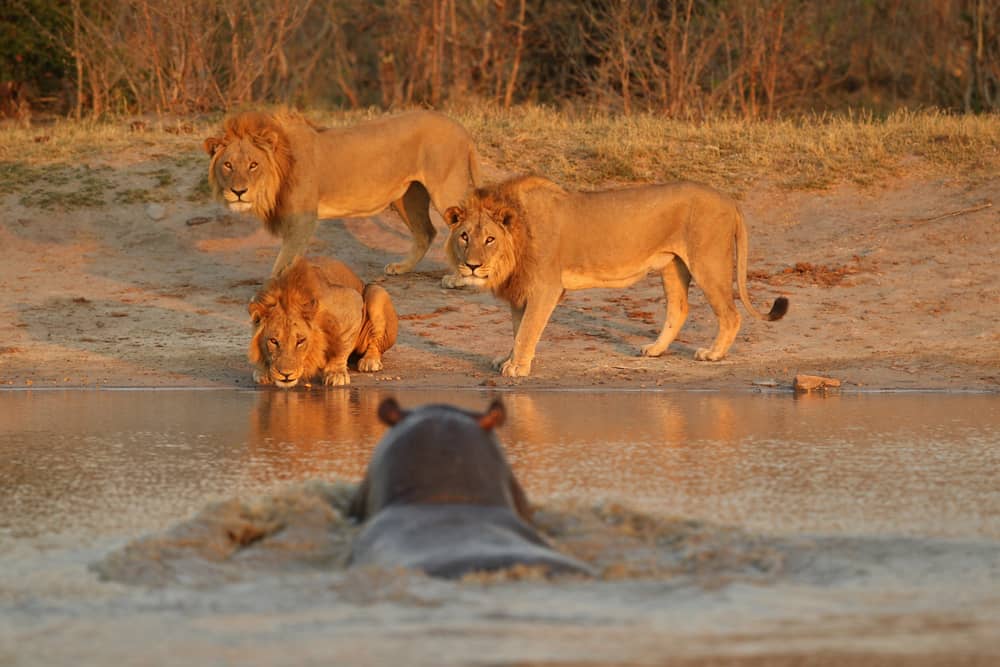
Hippos are not to be underestimated. Known for their territorial nature, they have been known to battle lions near water sources. Their massive size and strength make them a dangerous opponent. Hippos have been known to crush lions with their massive jaws.
It’s relatively rare for lions to attack hippos. Usually, these incidents would involve a young or injured hippo that is seen as easier targets. Even then, lions would typically only consider attacking a hippo if they are desperate for food or if the hippo is vulnerable due to age, sickness, injury, or on land.
7. Elephants
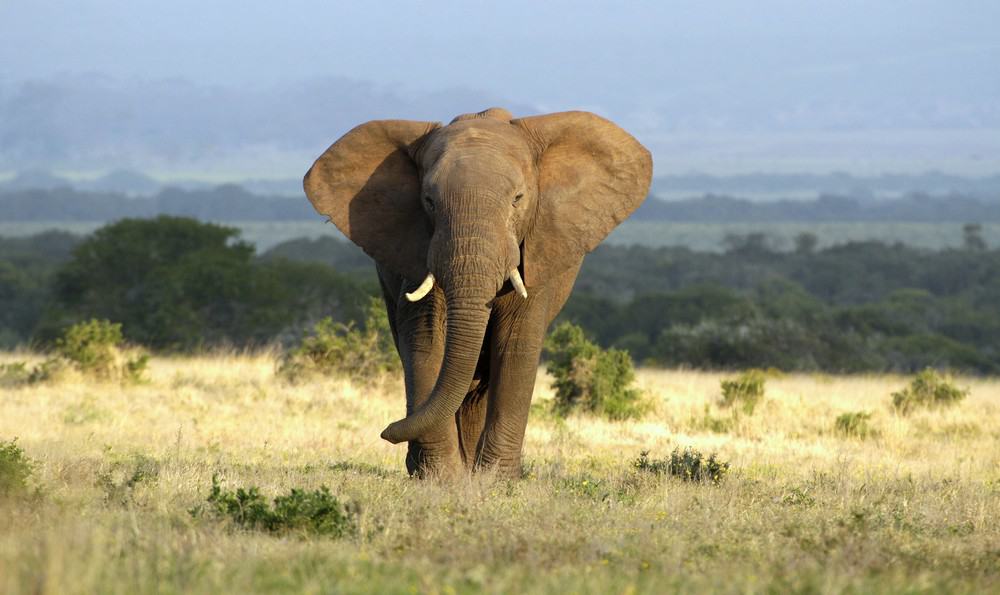
Elephants are the strongest land animals on earth. With their imposing size and sharp tusks, the largest land mammal in the world is not afraid of the lion’s apex predator status. Adult elephants are virtually invulnerable to lion attacks.
Elephants defensively circle their young and use their sheer mass and strength to deter lions. Rarely do lions target adult elephants, recognizing the risk far outweighs the potential reward. On rare occasions, lions may target young, sick, or elderly elephants, but such attempts are fraught with danger and are not undertaken lightly. Elephants can be proactive towards perceived threats, often chasing lions away with thunderous charges.
Interactions between elephants and lions are marked by a cautious respect.
8. Rhinos
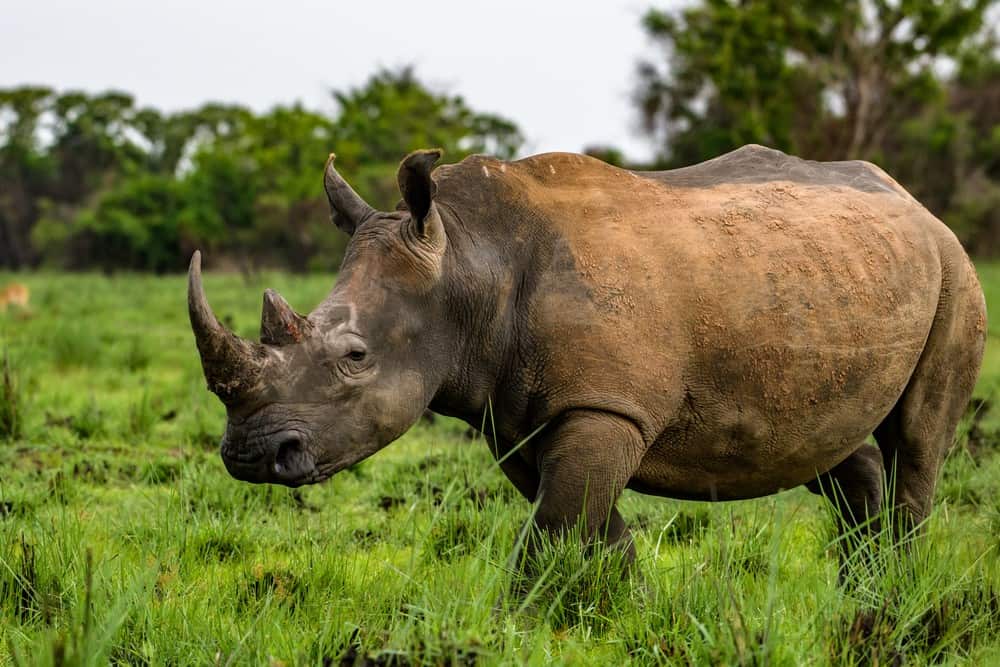
Rhinos, armored with thick skin and equipped with formidable horns, are not typical prey for lions. These solitary animals command a presence that lions often choose not to challenge. However, the vulnerability of rhino calves can draw the attention of a determined pride, though such attempts are perilous and rare. Vigilant mothers are a force to be reckoned with.
Rhinos are capable of inflicting fatal wounds with their horns. A rhino’s primary defense is to charge at high speed and attempt to gore the lion. The horn, made of keratin (the same material as human nails and hair), is incredibly tough and can pierce the body of a lion with ease.
Apart from using its horn, a rhino may also use its weight to its advantage by trying to trample the lion. The massive body weight of a rhino, which can be over 4,400 pounds (2,000 kilograms), is enough to crush a lion if it manages to pin it down.
9. Wild Dogs
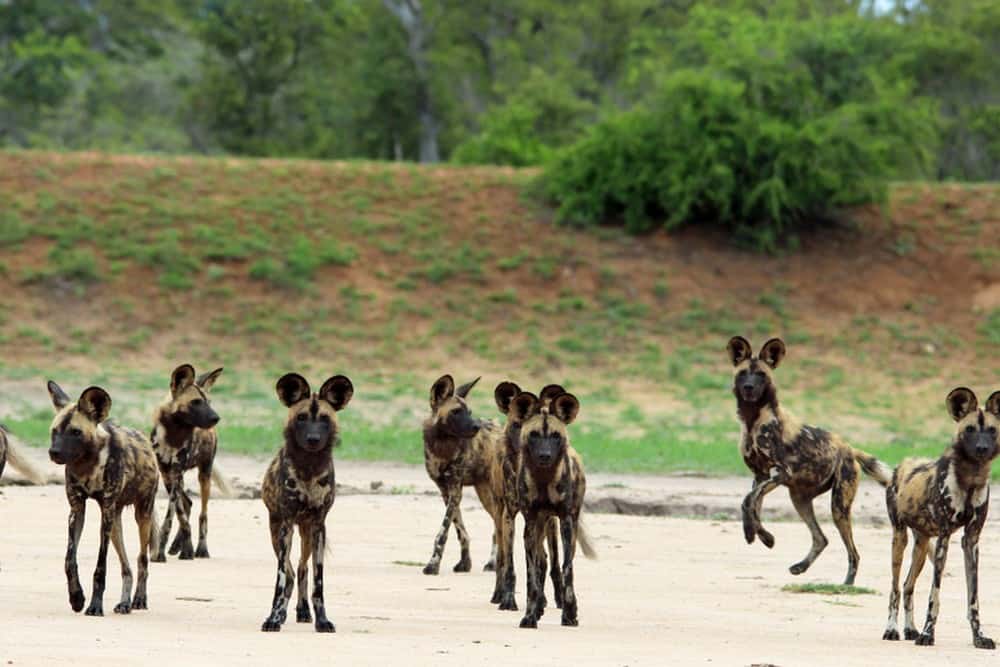
African wild dogs also find themselves at odds with lions. Lions are known to steal kills from wild dogs. Aware of the lions’ superior strength, the dogs will often vacate an area if they detect a lion’s presence to avoid confrontation. The wild dogs’ agility and speed often allow them to escape unharmed.
If necessary, wild dogs will band together to defend against a lion, using their numbers to their advantage. They have a strong pack mentality. To protect their young or to defend an injured pack member, they may try to harass a lone lion or a small group of lions with hit-and-run tactics.
However, when faced with a pride of lions, the dynamics shift dramatically. The dogs are generally outmatched in direct physical confrontations with lions and can sustain heavy casualties.
10. Porcupines
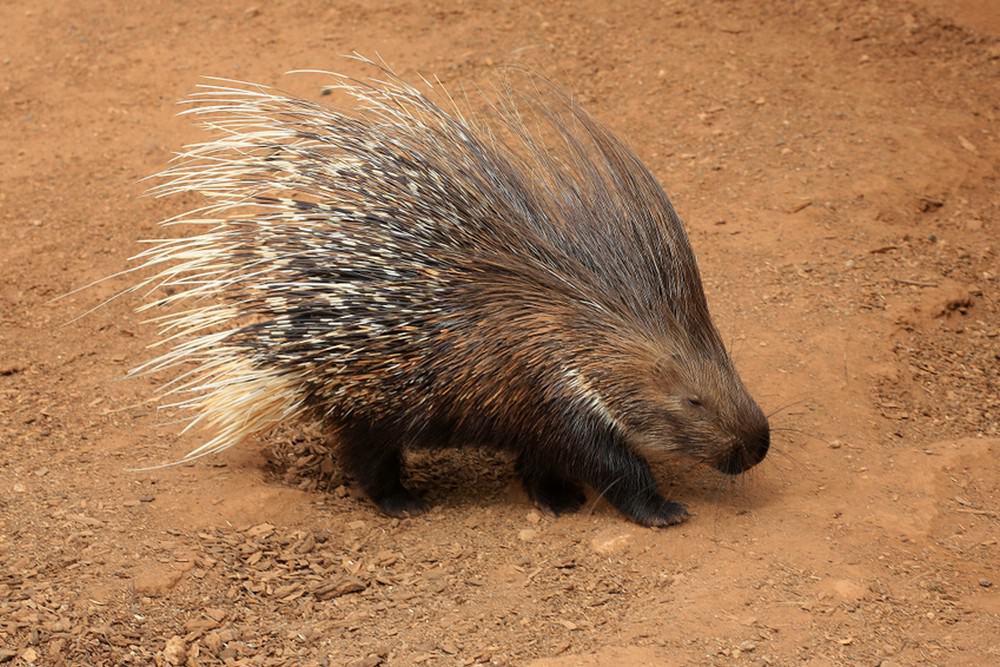
Porcupines can actually kill lions, leopards and hyenas. While they are seen as prey on the savannah, those that hunt them are taking big risks. The porcupine’s quills can detach and embed themselves into the flesh of any predator that attempts to attack it. Due to their barbed nature, the quills are difficult to remove and can migrate deeper into the lion’s body. This can lead to severe infections which can be potentially life-threatening.
Futhermore, quills can puncture vital areas, such as the mouth, throat, abdomen, or heart leading to critical injuries. In some cases, lions have been known to starve to death because quills embedded in their mouth or throat prevent them from eating. While direct deaths from quill injuries might be rare, the combination of infection, impaired ability to hunt, and subsequent weakness can lead to a lion’s death.
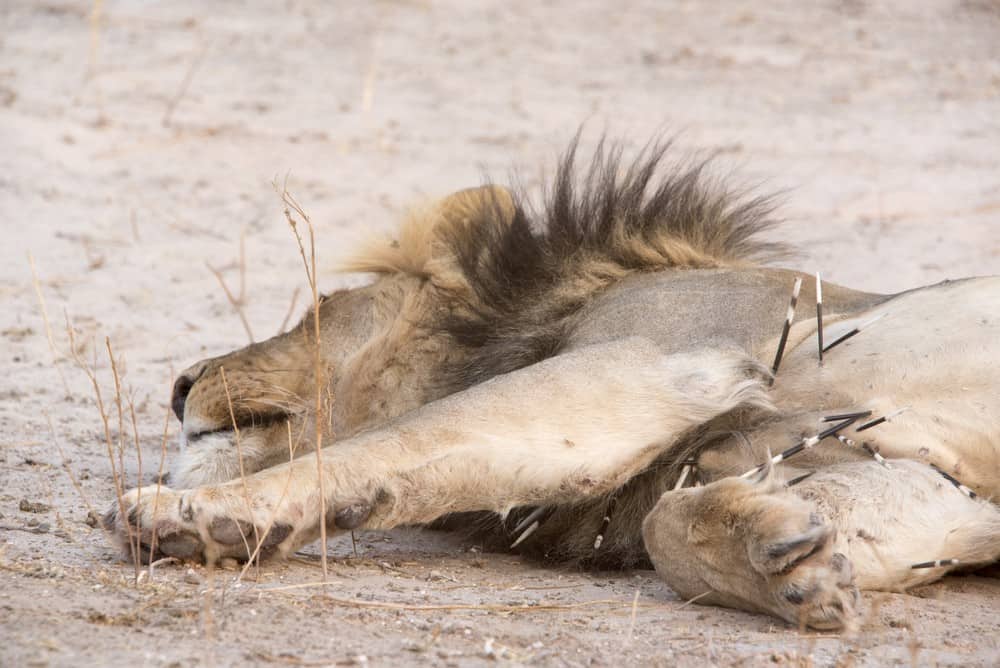
11. Humans
Beyond the natural world, humans emerge as the most significant threat to lions.
Through habitat destruction, poaching, and conflicts with livestock farmers, human activities have led to a dramatic decline in lion populations across Africa. These encounters remind us of the delicate balance between human expansion and wildlife conservation.
